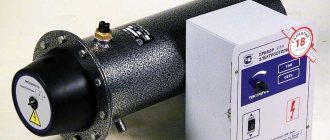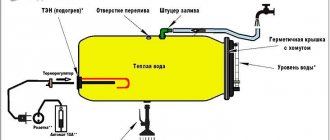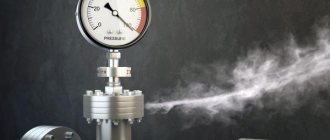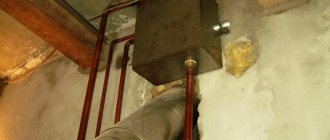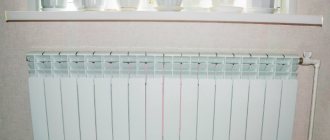No matter how zealous scientists and engineers are in searching for alternative heat storage and transmitters to liquid media from sources to end points of heat transfer, a worthy replacement for liquid media has not yet appeared. Water heating systems will remain the most common for a long time, as they are practical and quite efficient. They are called water-based, although it would be more correct to call them liquid, because they use not only water, but also other types of liquid substances as a coolant.
What is a coolant, requirements, properties
A coolant is a liquid substance that meets a number of operational requirements and is capable of effectively transferring thermal energy from the heating boiler circuit to the radiators in the room. In a simplified form, the principle of its operation is the following algorithm:
- The flow of substance washes the heating circuit of the heating boiler.
- Having acquired a given temperature, it then passes through pipes to receivers - radiators.
- In contact with the internal structures of the batteries, the thermal agent cools and transfers heat to the walls of the device, which in turn release it to the surrounding space.
- The cooled coolant, leaving the radiator, returns in the return line to the heating circuit and the cycle repeats.
Moreover, not every liquid can be used as a heat agent.
Scheme of autonomous heating at home Source survival.com.ua
Requirements
For successful and safe use, the liquid substance must meet the following series of requirements:
- The ability to quickly and fully absorb, transfer and release heat - which corresponds to a high value of heat capacity.
- Neutrality or the minimum possible chemical activity with contacting material - equipment, pipes, radiators and sealing elements.
- Wide range of operating temperatures – both in the heating and cooling zones. Ideally, the heating liquid should not boil quickly and turn into a vapor state at standard boiler operating rates. It should also not thicken or completely crystallize when cooled well below 0 °C and lead to destruction of system equipment in winter.
- The absence of dissolved components in the composition that can crystallize with constant heating of the liquid. Since they can be deposited in the form of insoluble growths on the walls of pipes, radiators and boiler circuits. This will lead to a narrowing of the working clearance and a deterioration in the heat transfer of the equipment, as well as a load on the pumping station.
Clogging of pipes with insoluble sediment Source ds-m.ru
- Absence or minimal corrosion activity on the metal surfaces of system elements.
- Chemical stability - the absence of processes of decomposition or transformation of coolant components into other compounds under the influence of heat, time of use and other factors.
- Constancy of performance characteristics - fluidity indicators, thermal capacity, chemical inertness, etc. - throughout the entire period of operation and under given conditions.
- Absolute safety for the residents of the house. Absence of toxic, flammable, explosive, radioactive and other components hazardous to life and health.
Important! Whatever the requirements, an ideal coolant does not exist in nature. Therefore, in each individual case, it is necessary to select a fluid that matches the nature of the application, equipment configuration, type of building, climate and other operating factors. Some boiler manufacturers directly recommend specific brands of products for filling the system.
Antifreeze supply system Source remont-book.com
In what systems can antifreeze liquid be used?
There are a number of restrictions on the use of antifreeze:
- Antifreeze liquid, regardless of its chemical composition, can only be used in a closed circuit. This means that there is constant pressure in the system, circulation is constantly forced, due to the pump.
- Coolants are not used with electrolysis-type electric boilers. Electrolysis type is when the coolant is used as an electrical conductor. The electrical conductivity of coolants is low, and this will lead to high energy costs.
- Antifreeze liquids must not be used in contact with galvanized surfaces (pipes).
Water as a coolant - pros and cons
Ordinary water is the most commonly used liquid for heating a private home. The main reason for this is accessibility. There are also a number of other advantages of its use:
- Natural prevalence . This makes water a free, accessible and easily replenished resource for any heating system. This not only reduces, but completely eliminates coolant costs for maintenance and repairs.
- Maximum heat capacity – high efficiency of heat transfer from the boiler to the radiator.
- Optimal technical indicators - fluidity, operating temperature, stability.
- Operational safety for people, animals, the environment and the equipment itself - does not burn, does not explode, does not poison.
However, the use of water in the heating system also has its disadvantages:
- High freezing point . When the ambient temperature drops below 0 °C, crystallization will occur with all the ensuing negative consequences - rupture of pipes, batteries, damage to equipment.
- Corrosivity . Water is easily and quickly saturated with oxygen, which, when in contact with metal surfaces of equipment, leads to rusting and destruction of its structure.
Pipes destroyed by corrosion Source gidpokraske.ru
- Formation of scale, growths, siltation. Due to the presence of dissolved impurities of various substances in ordinary water from natural sources, deposits of salts, silt and other components often form on the inner surface of pipes, circuits and batteries. As a result, the clearance narrows, heat transfer properties deteriorate and the service life of the equipment decreases.
Recommendation! Despite the obvious disadvantages, water is the most popular coolant for the heating system of a country house. However, in order to avoid the disadvantages associated with its use, some manipulations are carried out on it. For example, to get rid of impurities, it is boiled, distilled, passed through filters, or special additives are added to it.
Heat transfer fluids based on ethylene glycol
For some heating units to operate, it is necessary to use a coolant that freezes only at very low temperatures. Low-freezing coolant (or antifreeze) based on ethylene glycol is one of them.
The low temperature at which crystallization of these types of coolants begins depends on the ratio of the base component - ethylene glycol and distilled water in solution. To improve the performance characteristics of these coolants, a package of functional additives is added to their composition, which protect the metal surfaces of equipment from the corrosive effects of ethylene glycol.
Antifreeze is suitable for use in automotive cooling systems of internal combustion engines and in systems that are used for heating buildings, structures and as a coolant in various industries. It belongs to the category of mid-price coolants.
The temperature at which this type of coolant begins to crystallize can reach minus 70 °C and does not form deposits on the heat pipes.
Among the key characteristics of such a coolant are the following:
- low-freezing properties (freezing depends on the concentration of ethylene glycol in the solution);
- practicality and safety of use (during cooling and crystallization it acquires an amorphous structure - it does not expand significantly, and therefore is not capable of damaging the heating system equipment);
- contains a package of additives (protecting against corrosion, scale, foaming and stabilizing, antioxidant);
- does not change its original basic special properties throughout the entire service life;
- has a high initial boiling point in a closed system;
- does not have an aggressive effect on various materials (metal, plastic, rubber, textiles) during the warranty period, since the composition contains the necessary additives in sufficient quantities.
The main disadvantage of such a coolant is its toxicity. They are moderately toxic in terms of their effects on the human body (hazard class 3) and dangerous in terms of environmental parameters. For this reason, it is not used in open heating systems. When using it, it is important to prevent it from coming into contact with any objects. Otherwise, it would be advisable to replace them.
Antifreeze, types, features
Water purified from harmful impurities and inhibited by special additives still does not become an ideal coolant. Since it is impossible to get rid of the main drawback - freezing at 0 degrees. Therefore, today special antifreeze liquid is widely used everywhere.
Antifreeze antifreeze down to -30 degrees Source antifreez.ru
Properties and features of antifreeze
The main feature of using such a liquid is the operating temperature range suitable for winter operating conditions. Antifreeze for heating freezes at a much lower temperature than ordinary water. Besides this, it has other obvious advantages:
- The structure of antifreeze does not allow it to completely crystallize when the temperature drops, but only to transition from a liquid to a gel state. This essential property preserves the integrity and performance of pipes, circuits and batteries. Therefore, even if the temperature drops below critical due to an unexpected shutdown of the system in cold weather, the equipment will not defrost.
- Economical use due to the possibility of diluting the concentrate with distilled water. Most formulations are sold in concentrated form. The lower limit of their operating temperature is -60-70 °C. However, in most regions the ambient temperature rarely drops below -40-30 degrees. Therefore, the liquid can be diluted without loss of properties according to the factory instructions.
Antifreeze and distilled water for dilution Source koffkindom.ru
See also: Catalog of companies that specialize in engineering systems (heating, water supply, sewerage and others) and related work
- Chemical stability and inertness. Antifreeze contains components that do not decompose when heated within the performance parameters and are inert with respect to the equipment material. In this case, the liquid lasts for at least 5 years.
With all the obvious advantages and superiority over ordinary water, however, antifreezes also have a number of specific disadvantages:
- High viscosity values. For normal circulation through the antifreeze fluid system, it is necessary to provide greater pressure, which means using a more powerful pump. At the same time, it is unacceptable to use antifreeze in variations with natural circulation.
- Up to 15% lower heat capacity than water. For this reason, the overall efficiency of the system will be reduced. Consequently, greater energy consumption, the use of radiators with an increased area and an increase in their number will be required in order to achieve a normal heating effect.
- The high degree of fluidity of the substance forces a more careful approach to the selection of sealing elements and more frequent procedures for their maintenance, repair and replacement in all connecting units.
Replacing seals in the radiator Source stroy-podskazka.ru
- Toxic components in many coolants pose a direct threat to all living things in the surrounding space.
- The need to install a larger expansion tank is due to the increased expansion coefficient.
Important! It is unacceptable to use inexpensive options for an open-type expansion tank with antifreeze for two reasons - loss of the substance through evaporation and contamination of indoor air with toxic fumes.
Varieties
Non-freezing heating fluid can have a different chemical basis. On this basis, antifreezes are divided into the following categories:
- Ethylene glycol.
- Propylene glycol.
- Glycerol.
- Bishofite.
There are also compositions specifically used in electrode-type heating boilers. In addition, many users recommend using regular antifreeze as an alternative to modern antifreeze. Let's look at the features of each option in detail.
Ethylene glycol coolant Source dialrus.com
Ethylene glycol
This is the most common, accessible and cheap antifreeze for the heating system of a country house. Available in two forms - concentrated and diluted. The second option is applicable at temperatures down to -30 °C, concentrate - up to -65 degrees. Among the main features of its operation are the following:
- Foaming under strong heating and, as a result, the formation of gas plugs. Eliminated by adding additives and temperature control.
- Oxidation of zinc-coated surfaces despite the use of inhibitors.
- Chemical decomposition when heated above 110 °C. The problem is eliminated by automatic control of the boiler temperature.
- Possibility of insoluble precipitate formation due to overheating. As a result, the entire pipeline system becomes clogged.
Ethylene glycol is poisonous. Therefore, it can only be poured into closed-loop systems.
Closed heating Source ytimg.com
Propylene glycol
A non-freezing liquid for the heating system based on propylene glycol is at least twice as expensive as the analogue considered. However, despite this, he is in great demand. The reason is complete harmlessness to humans. In purified form, the compound is often added even to confectionery products as a flavoring additive. When used in heating systems, antifreeze exhibits the following series of properties:
- Increased fluidity, which implies strict control over the tightness of the system and places high demands on the sealing elements.
- Oxidation of zinc surfaces.
- Easy flammability - at 421 degrees.
- Service life – up to 10 years.
- Operating temperature – up to -50 °C.
Propylene glycol antifreeze can be used in open systems, as well as double-circuit junctions, when there is a risk of coolant getting into household water.
Glycerol
Glycerin coolant for heating is actually an analogue of the antifreeze discussed above. At the same time, it is 25% cheaper and is characterized by the following number of advantages:
- Non-toxic.
- Wide range of operating temperatures – from -30 to +110 degrees.
- Does not destroy pipes when frozen.
Glycerin-based coolant Source fabrikatepla.ru
Should I dilute with water or not?
The origin of this issue is due to the fact that equipment manufacturers set the same requirements, worrying about the safest and most efficient operation possible. Buyers stick to their line, driven by the need to save money. And coolant manufacturers maneuver between the requirements of manufacturers, buyers and sales practices. As always, the truth is somewhere in the middle.
Manufacturers of antifreeze liquids mainly offer “-65C” or “-30C” coolants to the market. Firstly, this is due to established demand, and secondly, such a coolant is guaranteed not to be frozen at the time of sale.
Equipment manufacturers have their own truth. Thus, the density of non-freezing liquid marked “-25C”, mainly recommended by equipment manufacturers for reasons of optimal fluidity, is 1.03 g/cm3, and that of liquid “-30C” is 1.04 g/cm3.
The fact that the content of the main substance in the coolant will be several percent higher is not an “exorbitant” deviation, but taking into account the fact that water can be “added” to the coolant either when recharging the circuit, or if water is not completely drained from the system after flushing , a “reserve” of concentration is simply necessary.
On the other hand, diluting the coolant from “-30C” to “-25C” - and this value is 3-4% - will not bring tangible savings to the buyer, but will increase the risk of losing other necessary properties. But in the case when the buyer plans to use concentrated coolant “-65C” and dilute it, the savings can already be up to 20%.
Rules for choosing antifreeze
An objective concept of which coolant is best to use in the heating system of a private house under specific conditions arises when taking into account the following series of criteria:
- Type of base and its applicability to equipment and operating conditions.
- Freezing and boiling points, optimal operating heating range - taking into account the dilution of the concentrate.
- Possibility of reducing concentration by adding water.
- Life time.
Note! Antifreeze is not recommended for use in open systems and with natural circulation. In addition, the antifreeze liquid should not come into contact with an unprotected galvanized surface and rubber, silicone seals, as well as oiled tow. In addition, only reliable automation can provide accurate control over compliance with its heating parameters.
Pouring antifreeze into the heating system Source hstream.ru
Experts do not recommend antifreeze for home heating
Molecule of ethylene glycol - a toxic substance
Let's figure out what is the reason for such a categorical position that it is impossible to pour antifreeze into the heating system of a house. To do this, let's start with the composition of antifreeze. It consists of:
- alcohol base;
- ethylene;
- inhibitors;
- compositions that prevent foaming.
This composition is typical for all foreign-made antifreeze liquids. Only as an active substance in addition to ethylene can there be:
This is the cheapest composition, it has the lowest temperature at which the structure of the additives decomposes. After this, the antifreeze simply destroys the heating circuit, corroding it from the inside. These are all the reasons why it is not recommended to pour antifreeze into the heating system of a house. In principle, the same can be said about ethylene glycol antifreeze, there is no difference. That is, experts are against the use of compounds with ethylene, and antifreeze is one of these.
It is designed for cars, so it is produced only with poisonous ethylene, because where it is used, this does not matter. Non-toxic propylene glycol and glycerin antifreezes are produced abroad.
Ethylene glycol, which is part of antifreeze, can cause chemical burns
Forewarned is forearmed. Knowing that antifreeze is poisonous, you can take measures to prevent it from causing harm. The use of antifreeze in the heating system must be carried out in such a way that the composition does not have access to the room where people are located. Therefore, it is better if antifreeze is poured into a sealed heating circuit. If you need it to circulate along an open circuit, then you need to modify the design of the expansion tank. The expanzomat must be hermetically sealed with a lid, and there must be a hole in the lid. A tube is inserted into it and leads outside. That's all, ethylene glycol vapors are no longer scary.
The only thing that is really dangerous about heating a private home with antifreeze is the possibility of a leak. There is no way to insure against this. In addition, due to the fact that antifreeze has a lower surface tension than water, it has greater fluidity. This means that it finds even the smallest cracks and leaks out. Moreover, if a leak appears, it will in no way disappear on its own, as is the case with water. It will leak constantly until the pipes and joints are repaired.
It is not always possible to detect a leak in a heating system immediately. It turns out that for some time everyone who is in the house, without knowing it, breathes ethylene glycol vapor. In general, such a composition is not used for permanent housing, but heating in a garage using antifreeze is another matter.
Most importantly, you cannot pour antifreeze into systems where there is a double-circuit boiler. If something goes wrong and part of the coolant gets into the DHW circuit, the consequences can be very serious.
Tips for use
Before you start pouring antifreeze into the heating system of a private home, you must consider the following set of recommendations:
- It is almost impossible to make a fairly accurate calculation of what concentration and corresponding physicochemical parameters an antifreeze liquid will require. Therefore, after filling, it may be necessary to increase the pump power, increase the volume of the expansion tank, increase the number of battery sections and even the cross-section of the heating circuit.
- Automatic valves for bleeding gas plugs may not work properly. Therefore, it is better to immediately install manual analogues, such as the Mayevsky crane.
- Before filling in new artificial coolant, the system must be washed with a special agent.
- To dilute the concentrate to the desired concentration, only distilled water can be used.
- After filling in compliance with all recommended standards, the system can only be started gradually. This is necessary to check the compatibility of all components with the new type of coolant.
Instructions for use
If your system previously ran on water, switching to antifreeze will not be easy. Theoretically, radiators with a boiler can be emptied and filled with cold-resistant coolant, but in practice the following will happen:
- due to lower heat capacity, the output of batteries and the efficiency of heating rooms will decrease;
- due to viscosity, the load on the pump will increase, coolant flow will drop, and less heat will reach the radiators;
- antifreeze expands more than water, so the capacity of the old tank will not be enough, the pressure in the network will rise;
- To improve the situation, you will have to increase the temperature on the boiler, which will lead to excessive fuel consumption and increased pressure.
Addition. After filling the liquid, the old connections sealed with flax and paint are guaranteed to flow.
Leaking joints must be repacked, sealing the threads with dry flax or thread with sealant
. In order for heating to function normally using a chemical coolant, you need to calculate in advance or remake the existing system according to the new requirements:
- Select the capacity of the expansion tank at the rate of 15% of the total volume of liquid (water was 10%);
- The pump performance is assumed to be 10% more, and the generated pressure is assumed to be 50% more. Let us explain with an example: if previously there was a unit with a working pressure of 0.4 Bar (4 meters of water column), then use a 0.6 Bar pump for antifreeze.
- In order to operate the boiler in optimal mode and not raise the temperature of the coolant, it is advisable to add 1-3 (depending on power) sections to each battery.
- Pack all joints with dry flax or use high-quality pastes - sealants such as LOCTITE, ABRO or Hermesil.
- When purchasing shut-off and control valves, consult with the seller about the resistance of rubber seals to glycol mixtures.
- Pressure test the system again by filling the pipes and heating equipment with water.
- When starting the boiler unit at negative temperatures, set the minimum power. Cold antifreeze needs to be warmed up slowly.
Advice. The total amount of coolant is easy to calculate - the cross-sectional area of the pipe is multiplied by its length, the capacity of the boiler and radiators is indicated in the product data sheets. Find out how to properly place and connect the expansion tank in our separate publication.
Before pumping in frost-resistant liquid, fill in water and test the pipelines with a pressure exceeding the operating pressure by 25%. The
concentrated coolant must be diluted with water, ideally with distillate. Do not rely on an excessive reserve of frost resistance - the more water you add, the better the heating will work. Recommendations for preparing coolant:
- For heating elements, electric and gas double-circuit heat generators, prepare the mixture at minus 20 degrees. A more concentrated solution may foam upon contact with the heater, and carbon deposits will form on the surface of the heating element.
- In other cases, mix the components at freezing point according to the table below. Proportions are indicated per 100 liters of coolant.
- If there is no distillate, first conduct an experiment - dilute the concentrate in a jar with plain water. If you see a precipitate of white flakes - a product of the decomposition of inhibitors and additives, this water should not be used.
- A similar check is done before mixing antifreeze from two different manufacturers. It is unacceptable to dilute ethylene glycol with propylene composition.
- Prepare the coolant immediately before pouring.
The ratio of concentrate and water is given per 100 liters.
To find out the amount of ingredients for a volume of 150 liters, multiply the given figures by a factor of 1.5. The maximum service life of any non-freezing substance in pipes and heating radiators is 5 years. At the end of the specified period, the liquid is drained, the system is flushed twice and filled with fresh antifreeze.
TOP 10 best antifreezes
In order to choose the best antifreeze for your heating system today, you need to consider the TOP 10 products from modern manufacturers:
- DIXIS-65.
Universal for gas and electric boilers. Works down to -65 degrees. Service life 5 years.
- Warm House Eco.
Based on propylene glycol - harmless. Compatible with sealants and tow. Does not destroy pipes when frozen.
- THERMAGENT-65.
Retains properties for up to 20 seasons. Suitable for low temperature climate areas. Contains ethylene glycol.
What is the service life, how do you know: when to replace?
The question is quite common.
Andreic
Experts, clarify the situation: today contractors said that antifreeze has a validity period of 5-7 years. Then it loses its properties, begins to precipitate, and generally does not flow through the heating system as it should. True or not?
For coolants that contain organic (carboxylate) additives, the service life is 10 seasons (10 years), for coolants with “ordinary” silicate additives, this period is about 5 years (heating seasons). In order to control quality, every year, after the end of the heating season, you can carry out a simple procedure - pour a small amount of coolant into a transparent glass container. The resulting sample is visually inspected for the presence of mechanical and other impurities, color, and transparency. If the coolant contains mechanical impurities (crumbs, grains of scale), it can be drained, filtered, flushed the system and refilled. If there are traces of chemical changes (flakes, clots), you need to contact a specialist.
Video description
Video about what you need to consider when pouring antifreeze into the heating system:
- RODA.
Glycerin coolant, works down to -30 degrees. Does not require rinsing before filling. Completely safe.
- AMT-300.
Designed for closed systems, applicable down to -15 degrees. Does not cause corrosion. Requires powerful pumping equipment.
- Hot Stream.
Based on ethylene glycol with additives. Serves for 10 years, works at temperatures down to -30 degrees. Available in diluted form.
- Teplokom.
Based on food grade glycerin. Completely safe. Suitable for use in systems with steel and aluminum radiators. Valid down to -50 degrees.
- WARME BASIC-65.
Contains ethylene glycol. Applicable down to -65 °C. Suitable for northern regions. Service life 2 years.
- Thermagent Eco 30.
Based on propylene glycol. Maintains performance characteristics at temperatures down to -30 degrees. Safe, lasts up to 10 years.
- FTX-30.
Coolant with additives based on propylene glycol. Freezes below -30 degrees. Does not corrode seals.
When choosing a coolant, price is not the last thing. However, more important characteristics are equipment efficiency and safety.
What happens when you mix different colors?
Hands down, nothing will happen if you mix formulations from different manufacturers, although there are certain conditions. Situations can be different, including force majeure, so read the ingredients first. If green G11 is mixed with green, but from a different manufacturer, with the most similar parameters, the engine will not be damaged. This also applies to other standards. Only coolant products of the same color and additives can be mixed with each other.
Now about the “traffic light”. As mentioned above, the same G11/12/13 can have a wide palette of shades. Antifreeze of different colors with an identical formula will interact perfectly with each other. The main headache for motorists is the G13 in purple and yellow. Many are afraid that they are completely different, although this is fundamentally false. Let's start with the fact that this antifreeze is universal in nature and has a double portion of additives that get along with each other without any special consequences. You will just get a new shade, nothing more.
Features of pouring coolant into the heating system
For successful and trouble-free operation of autonomous heating of a private home, it is important not only to know which coolant is best to use in the heating system, but also how to fill it correctly. There are two main ways to do this:
- By gravity.
- By pump.
In the first case, the liquid is poured through an open socket at the highest point of the heating piping system. The method is quite simple, but requires a lot of effort and time. More suitable for small-volume open systems operating in a one-story house.
The second is more preferable when large volumes of coolant need to be filled. In this case, the use of both submersible and pressure testing pumping equipment is allowed. The main nuance of pumping coolant in this way is to eliminate or minimize the entry of air into the system.
The procedure for pumping coolant into the heating system must be carried out by experienced specialists strictly in accordance with the technology and control of technical parameters of pressure and volume, as well as the removal of air pockets.
How to do this correctly?
First, you should remove the old antifreeze from the tank - it is located in the radiator and also in the cylinder block. When carrying out work, the car should be placed on a hill - this way much more of the cooling mixture will drain out. The system should be flushed with distilled water; It’s also worth adding special. means for carrying out work.
Antifreeze should not be poured into the car to the brim, the lid should be open, then the car engine is turned on again and the air is released into the space. Afterwards the neck should be screwed on. Prepare and place a container under the cooling drain points in advance. mixtures in cars. Next, you should unscrew the drain valve on the cooling system. You need to open it as carefully as possible, and do this while pouring antifreeze. Perform the draining itself slowly. After you have drained the main part of the coolant
mixture, unscrew the lid. It is also worth paying attention to the fact that the pipe systems and tap can be located at different points, since much depends on the design solutions of the car. After draining the car's coolant, you should seal the cooling system by turning off the pipes and the valve. After that you can start filling in a new portion of antifreeze. To prevent the mixture from spilling, it is worth placing the watering can in a special expansion tank or insert it into the radiator
It is usually located under the hood; Next, take a container and fill it with antifreeze. This should be done gradually, while trying not to pour all of your antifreeze into the tank in one fell swoop. It is worth remembering that if the pressure is too high, a water plug may appear. It is also worth noting that the extension. The tank usually has a maximum fill mark and a minimum fill mark. That is why it is recommended to pour no more cooling mixture than the set level. When pouring antifreeze or antifreeze, it is worth screwing the cap of the expansion tank tighter.
This is essentially almost all actions. Now you understand how to properly fill in antifreeze (you can understand in more detail in the video below). After all these procedures, it is better to play it safe and start your car, allowing it to reach the required temperature.
Also check how the car's cooling system works and what condition it is in. Check the antifreeze level in it.
Briefly about the main thing
The coolant for heating a private house allows you to efficiently and safely transfer thermal energy from the heating circuit of the boiler to the radiators, which in turn release heat to the surrounding space. The coolant must meet the following series of requirements:
- Complete heat transfer.
- Chemical inertness.
- Optimal operating temperature range.
- Absence of harmful components.
- Stability and constancy of operating parameters.
- Safety for people and the environment.
Water can be used as a coolant. It tolerates heat best, is free and accessible. However, it freezes already at zero degrees, causes corrosion and can form insoluble salts. Non-freezing liquids do not have such disadvantages.
Antifreezes are divided according to their chemical composition into ethylene glycol, propylene glycol, and glycerin. There are also special ones for electrode boilers and mineral ones. Antifreeze cannot be used as a cheap alternative. You can add antifreeze manually or with a pump. At the same time, monitoring performance characteristics and strict adherence to technology are extremely important.
Ratings 0
The main characteristics that you need to focus on when choosing a coolant
There are a number of requirements for work environments. Each of them is a specific characteristic of coolants for heat exchange systems, including heating processes.
- Good heat storage capacity, allowing to reduce energy costs for movement.
- Transportability. It is important to have a stable state of aggregation and the ability to transfer heat (cold) over the required distances.
- Low level of toxicity or its minimal impact on the health of personnel.
- Environmental Safety. It is necessary that possible unintended leaks and emissions do not have a negative impact on the environment.
- Chemical inertness in relation to materials of heat exchange systems and technological equipment of various industries (metals, alloys, sealing products, rubber, etc.).
- Optimal operating temperature range, which ensures stability of heat transfer and stable control of the modes of various production processes and reduces operating costs.
- Explosion and fire safety. It is important that the heated coolant does not ignite when in contact with air.
Some physical characteristics are no less important: a high thermal conductivity coefficient, the value of the coefficient characterizing surface tension and the optimal viscosity value over a wide temperature range.
specializes in the production and sale of industrial coolants of a wide range of different brands.
For reference
If you are faced with the task of how to fill the heating system in your personal home, you must ensure that water in its ordinary form should not be used, because it is rich in salts and oxygen. Over time, such additives will cause scale to settle on the internal surfaces of the heating system and rust will occur. A In order for the system to work without interruptions, the liquid must be weakened before use.
To do this, use one of the available options. This may be a thermal or chemical technique. In the first version, the technique is based on boiling. The water must be placed in an iron tank, in which it must be heated. When boiling, carbon dioxide will be removed, and salts will be deposited at the bottom of the vessel. Stable compounds of magnesium and calcium will still remain in the water mass. The chemical method works using reagents. With the help of soda ash, sodium orthophosphate and slaked lime, the salts become insoluble and precipitate. Further filtration will make it possible to remove the remains of harmful substances.
What does antifreeze contain?
When developing antifreeze, we used the recommendations of Italian developers, and even acquired a license for the production of coolants. But the very first tests showed that the Italian recipe does not work in Russian conditions. Even in the Central region, frosts down to -40...-43 ⁰С are possible, and the imported coolant was designed for -25 ⁰С. Therefore, composition adjustments were required.
The main component is ethylene glycol (C₂H₄(OH)₂). This is a high-boiling alcohol, the share of which in antifreeze can range from 40 to 65%. The second component of the coolant for cars is distilled water.
With regular use of ordinary liquid, the thickness of the scale layer can reach several millimeters. Heat transfer will be disrupted to such an extent that the performance of the cooling system will be extremely low.
When creating antifreeze, we noticed that the mechanical mixture of the main liquids is quite aggressive towards some types of plastics and rubber. C₂H₄(OH)₂ dissolves certain types of plastics and also reacts with sulfur used in the vulcanization process of natural rubber
Therefore, detergent additives were added to the composition. Their number is less than 1%. Practice has proven that even a minimal amount of such substances prevents contact between polymers and alcohols.
Another disadvantage of the usual mixture of water and ethylene glycol is the formation of foam when circulated intensively. Anti-foam additives began to be added to antifreeze in 1979 after motorists had complaints about the operation of the cooling system: foam began to release from the expansion tank of cars operated in the summer. This is the result of the interaction of alcohol (C₂H₄(OH)₂) with aluminum alloys.
Coolant under the brand “Tosol A40M” is produced at several enterprises in Russia and neighboring countries. The composition has not changed for 40 years.
Differences between antifreeze and antifreeze
Today, three types of coolants for internal combustion engines are used: water (distilled or pure rainwater), antifreeze and antifreeze.
Antifreeze is the name of the liquid (translated as “anti-freeze”) for the engine cooling system, which does not freeze and can withstand high temperatures.
Differences:
- antifreeze was invented later than antifreeze;
- Antifreeze is better in terms of environmental friendliness;
- The boiling point of antifreeze is higher;
- The freezing point of antifreeze is lower;
- Antifreeze provides better protection against corrosion.
- Antifreeze forms a protective film, but antifreeze does not, and therefore antifreeze cools much more efficiently.
- The service life for which antifreeze is designed is 6 times less than that of antifreeze.
- antifreeze protects engine cylinder liners from cavitation (air bubbles).
- The service life of the pump (pump) is significantly reduced if antifreeze is used.
- antifreeze does not clog radiators, and various types of deposits do not form.
The main disadvantage of antifreeze is that when heated to 105 degrees, its properties deteriorate.
Antifreeze boils when heated to 115 degrees and does not leave sediment in the channels and can be used for up to 250,000 km.
The confusion about the colors of antifreeze and antifreeze infuriates any motorist. During the 2 years that the cooler is in operation and the driver does not bother replacing it, resilient manufacturers come up with new standards and variations of their products, which only plays into the hands of marketers, but not the consumer.
You also can’t stock up on coolant for future use due to the limited shelf life. Try to choose one manufacturer, find an intelligent seller who will explain in detail what the difference between the compositions is. And you yourself will learn to read the list of ingredients in order to significantly save on the service in the future.
How to determine what is flooded?
It will not be possible to check and recognize using color what is in the car. Antifreeze is always colored blue. But modern antifreezes are also available in blue.
If you don’t know what’s in the car, you can determine the type of consumables based on several factors:
- Smell and taste. Antifreezes are usually odorless, and if you touch the liquid, it will be more oily, unlike traditional antifreeze.
- Determining the type of liquid can be done by diagnosing the compatibility of the refrigerant with ordinary water. You need to take a little substance from the expansion tank and mix it with tap water in a 1:1 ratio. Afterwards, the container with the refrigerant is placed in the freezer for about one hour. If, as a result, the liquids separate, the mixed substance becomes cloudy and sediment forms at the bottom, then you use Antifreeze. If high-quality antifreeze is poured into the cooling system of your car, then such problems will not arise.
- Another factor is resistance to negative low temperatures. Pour a small amount of refrigerant into a separate bottle and place it in the freezer. When using Antifreeze, the liquid will quickly freeze, but if a good refrigerant is added, this will not happen.
- Using a hydrometer, you can diagnose the density indicator of a substance. The test should be carried out at an air temperature of 20 degrees. With this condition, the refrigerant density parameter should be about 1.073-1.079 g/cm3. If so, then you are using antifreeze.
For diagnosis, you can resort to the old “old-fashioned” method:
- You will need a plate or other metal device. You will also need a rubber product, for example, a piece of hose from the cooling system.
- Take some fluid from the reservoir under the hood of your car. You need to pour it into a jar or bottle, where you should also place a plate and a piece of hose.
- After 20 minutes, look at the result. Russian-made consumables create a protective layer on all components of the cooling system. Accordingly, you will see a barely noticeable film on both the plate and the piece of hose. If the metal is corroded, and a film has formed only where rust is present, then you use antifreeze. Remove the products from the container and check them by touch.
How can you tell what kind of antifreeze is in your car from the factory?
To understand what brand of refrigerant to add to the refrigeration system, you need to know what is initially added from the factory. You won't be able to determine this on your own. An accurate conclusion can only be given by the results of laboratory tests. Alternatively, you can contact your dealer or read the service manual. It indicates which standard of refrigerant should be used.
You can learn about mixing refrigerants and the results from the video filmed by the Avto-Blogger.ru channel.
Is it possible to fill something in if you don’t know?
If the situation is urgent, for example, while driving you had to stop because the engine overheated, then you can also pour water into the cooling system. If this happens during the cold season, we recommend that you do not ride on water for a long time, but rather drive to the nearest service station or garage to solve the problem. Even when adding fluid in the warm season, after using the car, the cooling system is flushed. In cold weather, water will quickly freeze, and it has the property of expansion, so freezing will damage the expansion tank and pipes.
It is possible to mix only those refrigerants that correspond to each other in composition and standard. Mixing antifreeze and antifreeze is not allowed. This will lead to a chemical reaction, as a result of which the liquid will lose its properties and will not be able to perform its duties. Precipitates form in the cooling system, which prevents the normal circulation of consumables through the lines. Due to the loss of properties, corrosion will appear on the internal parts of the radiator device, which over time will lead to serious damage to the unit.
If you had to mix Antifreeze with antifreeze, then do not delay the replacement process. It is necessary to drain consumables. When changing, the engine is flushed, and the procedure is repeated several times. This is done until clean water without deposits or traces of scale begins to come out of the cooling system. Then we can assume that the cleaning was completed successfully. For washing it is allowed to use special means. When filling, take into account the engine specifications and the manufacturer's recommendations for the use of antifreeze.
What should the coolant be?
If you have a question about how to fill the heating system in your personal home, then you must figure out what the coolant should be. No model liquid for this role has yet been invented. This indicates that any of the popular materials is in use under specific conditions.
A significant factor is the temperature of the coolant, if violated, the substance can change its own properties, which leads to the system stopping. A good thermal fluid should transfer a decent amount of heat in the shortest possible time, it should have low viscosity, it should not cause corrosion and it should not pose a danger to the inhabitants of the house. In addition, when transferring heat, heat loss must be very small, and low viscosity will be an indicator of the pumping speed and increase in efficiency.
If you are faced with the question of how to fill the heating system in your personal home, you must know that one or another coolant will cause corrosion, due to which you will encounter restrictions when choosing mechanisms and parts of the system.



